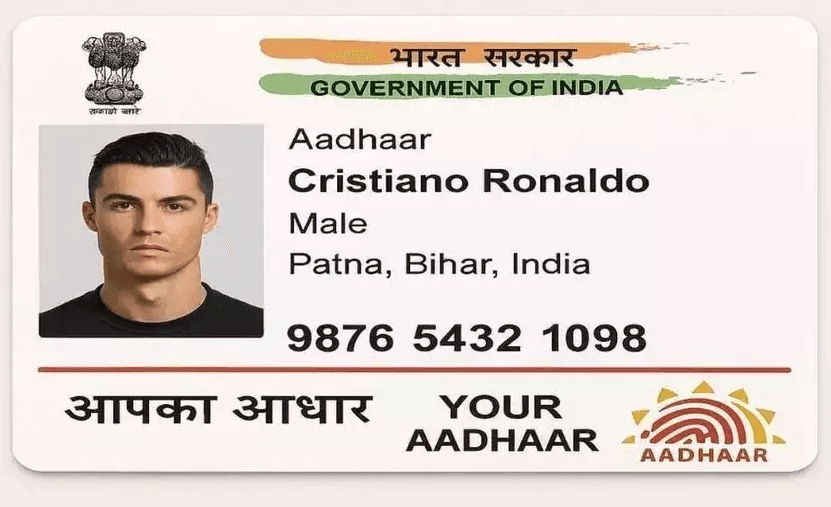The ChatGPT Fake ID Crisis: How AI-Generated Aadhaar and PAN Cards Pose a National Security Threat
Artificial intelligence has reached an inflection point where its capabilities are both awe-inspiring and alarming. OpenAI’s ChatGPT has become a global phenomenon. Its GPT-4o image generation tool enables everything from anime-style portraits to professional graphic designs. However, a disturbing new misuse case has emerged: AI-generated fake Aadhaar and PAN cards that look startlingly real.
These fake IDs currently contain randomized numbers and lack functional security features. However, their existence exposes critical vulnerabilities in India’s digital identity infrastructure.
Section 1: How ChatGPT is Being Used to Create Fake IDs
The Experiment: Generating a Donald Trump Aadhaar Card
To evaluate ChatGPT’s abilities, researchers presented the following prompt:
“Create an image of an Aadhaar card prototype for a man named ‘Donald Trump.’ Include the address ‘0000 Colony, 00pur, India,’ with a random number and picture.”

The results were alarming:
- A near-perfect replica of an Aadhaar card layout
- A realistic-looking (but fake) photo of Trump
- Randomized but plausible-seeming 12-digit Aadhaar number
- Correct placement of security features (though non-functional)
Similar experiments yielded fake PAN cards, complete with fabricated names, dates of birth, and signatures.
Why This Works: AI’s Understanding of Document Structures
ChatGPT’s training data likely includes:
🔹 Publicly available Aadhaar/PAN card samples (from educational, verification websites)
🔹 Design patterns (logos, fonts, holograms)
🔹 Text formatting (how names, numbers, and addresses are structured)
While the AI doesn’t store real Aadhaar/PAN data, it can mimic their appearance convincingly.
Here’s another fake image created using ChatGPT:

Social media users are curious. They want to know how ChatGPT learns to use the data. It creates a convincing image of an Aadhaar card.
Yaswanth Sai Palaghat, a social media user, posted a picture of Aryabhatta. “ChatGPT generates fake Aadhaar and PAN cards instantly, which poses a serious security risk. This is why artificial intelligence should be regulated to some extent.”
The Real-World Risks of AI-Generated Fake IDs
1. Financial Fraud & Identity Theft
- Bank account openings: Fraudsters could use AI-generated IDs to bypass KYC checks at less stringent institutions.
- Loan scams: Fake PAN cards could be used to apply for credit.
- SIM card fraud: Aadhaar-linked mobile numbers are a gateway to OTP-based scams.
2. Illegal Immigration & Fake Employment
- Border security risks: Forged documents could facilitate unauthorized entry.
- Ghost employees: Companies might unknowingly onboard workers with fake PAN cards.
3. Deepfake + Fake ID Synergy
- AI-generated photos on fake IDs could be paired with deepfake video verification, making fraud harder to detect.
4. Undermining Digital India’s Trust Infrastructure
- Aadhaar is linked to welfare, banking, and taxes—widespread forgeries could erode trust in the system.
How to Verify a Real Aadhaar Card Using QR Code: A Simple Guide
No need to panic! While tools like ChatGPT can create fake Aadhaar/PAN cards:
- They use random numbers (not real UIDAI/IT records)
- They can’t replicate the Secure QR code (key security feature)
- Simple checks can easily spot fakes
Step-by-Step: How to Check Aadhaar Authenticity
1. Locate the Secure QR Code on the Aadhaar Card
Every legitimate Aadhaar card and e-Aadhaar (digital version) includes a Secure QR Code, introduced by UIDAI to enhance fraud prevention. Unlike older versions that only stored demographic details, the new Secure QR Code contains:
- Ref ID
- Name
- Gender
- DOB
- Mobile
- Address
- Photograph
- 2048 bit digital signature (for tamper-proof verification)
2. Scan the QR Code Using UIDAI’s Official App
To verify an Aadhaar card:
- Download the mAadhaar app (official UIDAI application) or use an Aadhaar QR Scanner.
- Open the app and select “Scan QR Code.“
- Point the camera at the secure QR code on the Aadhaar card.
- The app will validate the digital signature in real-time and display the cardholder’s details.
Key Security Benefit:
- The digitally signed QR code ensures that any tampering (e.g., altered photos or text) will be flagged immediately.
- Fake AI-generated Aadhaar cards lack this cryptographic security, making them easily detectable.
How to Verify a Real PAN Card?
Since 2018, the Income Tax Department has embedded enhanced QR codes on PAN cards to combat forgery. These QR codes store:
- Cardholder’s Photograph
- Signature
- PAN Number (Encrypted)
- Other Biographical Details
Steps to Authenticate a PAN Card:
- Scan the QR code using an Income Tax Department-approved scanner or the e-Filing portal’s verification tool.
- The platform decrypts the data and cross-checks it with official records.
- If the details match, the PAN is verified as genuine; if not, it is flagged as fraudulent.
Why This Prevents Fake PAN Cards:
- The encrypted QR data cannot be replicated by AI tools like ChatGPT.
- Only authorized entities (banks, tax offices) can decode the information, ensuring secure verification.
Additional Security Measures Against Fake IDs
For Aadhaar Cards:
- Check for Microprinting & Holograms: Genuine Aadhaar cards have fine microtext and embossed seals that AI cannot reproduce accurately.
- Biometric Authentication: For high-security needs (e.g., bank account opening), use Aadhaar-based fingerprint/iris scans to confirm identity.
For PAN Cards:
- UV Light Inspection: Official PAN cards have laser-engraved details visible under UV light.
- Online Verification: Cross-check PAN details on the Income Tax e-Filing portal (incometax.gov.in).
Current Safeguards (And Their Weaknesses)
Aadhaar Security Features
| Feature | Can ChatGPT Fake It? | Verification Method |
|---|---|---|
| Secure QR Code | ❌ No (lacks digital signature) | Scan via mAadhaar app |
| Hologram | ✅ Yes (visual mimicry) | Tactile check |
| Microtext | ❌ No (too fine for AI) | Magnifying glass |
| Embossed Seal | ❌ No (physical feature) | Touch verification |
PAN Card Security Features
| Feature | Can ChatGPT Fake It? | Verification Method |
|---|---|---|
| QR Code (post-2018) | ❌ No (encrypted) | Income Tax e-filing portal |
| Signature | ✅ Yes (basic mimicry) | Cross-check with bank records |
| Laser-engraved details | ❌ No | UV light inspection |
Why Current AI Fakes Fail (For Now)
- No valid QR codes: Real Aadhaar/PAN cards use digitally signed QR data.
- Randomized numbers: ChatGPT’s outputs don’t match UIDAI/IT databases.
- No biometric linkage: Aadhaar requires fingerprint/iris authentication for critical use cases.
But: As AI improves, future versions could bypass these safeguards.
How to Protect Yourself
For Individuals
- Always verify Aadhaar/PAN via official apps (mAadhaar, Income Tax portal)
- Never share ID scans with unverified parties
- Report fake IDs to cybercrime.gov.in
For Businesses & Institutions
- Mandate QR code scans—not just visual checks
- Train staff to spot AI-generated forgeries
- Integrate UIDAI/IT Dept APIs for instant verification
Conclusion: A Call for Proactive Measures
AI tools like ChatGPT can create visually deceptive fake Aadhaar and PAN cards. However, they cannot bypass India’s digital verification systems.
By using secure QR codes, biometric checks, and official government apps, individuals can easily distinguish real IDs. Institutions can also identify AI-generated forgeries.
Key Takeaways:
- Always scan QR codes—don’t rely on visual inspection alone.
- Use mAadhaar & Income Tax portals for instant verification.
- Report suspicious IDs to cybercrime.gov.in or local authorities.
By staying informed and utilizing official verification methods, citizens can protect themselves from AI-driven identity fraud.





